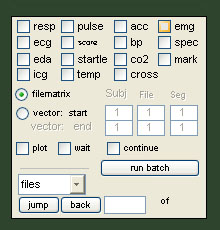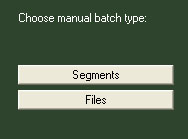batch processing
Most analysis types in anslab can be run noninteractively in batch
mode for an arbitrary number of files. This is especially useful for
channels, that don't require heavy editing, like emg, accelerometer,
temperature and marker. Other analysis types can also be automatized,
but very likely need to be checked afterwards. Anslab offers a fully
automatized batch mode, that does not show what it is doing, and a
semi-automatized mode, that gives you full control of editing features,
but saves you a few loading dialogs. Both types are described below:
Fully
automatized batch processing: this type of batch
processing is run from the 'batch'-tab in the
dynamic
section of anslab command window. A number of checkboxes can be
activated
for the corresponding anaylsis types. These analysis types are run for
every file in the batch, you cannot choose to run a specific set for
every file.
The list of files to process can be specified in two alternative
ways: either using a text-file containing the paths of all files
to
be processed with one path per line ( the filematrix option ) or using
a specified range of subject numbers, file numbers and segment
numbers to look for. For the former option, create and load a
filematrix using the  create batchfile and
create batchfile and  load
filematrix - commands. For the latter, anslab will deduce the paths
of the
files automatically (raw files must be located in the 'raw'-subfolder
of the study-folder ) and work them off. If a file is not found in the
location specified, anslab continues with the next file in line.
load
filematrix - commands. For the latter, anslab will deduce the paths
of the
files automatically (raw files must be located in the 'raw'-subfolder
of the study-folder ) and work them off. If a file is not found in the
location specified, anslab continues with the next file in line.

Semi-automatized
batch processing: this type of batch processing is run like
manual processing, except that a filematrix (batchfile) must be loaded
beforehand and that instead of using the open data file(s) - button,
the next - button is used for
starting the analysis. You are prompted to select a type of batch
processing with
the dialog shown below:

This refers to wether you are processing files as multiple segments
or as entity. If you choose Segments,
anslab reads the associated timing file and processes the next segment
of the file, when you hit the next button. Only if all segments have
been processed, anslab jumps to the next file. If you choose Files, anslab jumps directly to the
next file in the batch. Note that during the analysis of a file, you
still have to use the resume-button
to advance in the processing steps, just like during manual
analysis. You can navigate through the files or segments, e.g.
after changing
settings in the options dialog or for skipping bad data
files/segments,
using the jump- and back-button in the dynamic section
of anslab command window. You can also jump to specific file/segments
by
entering a number in the edit-box on the right of these buttons. Wether
files or segments will be jumped is set using the
files/segments-dropdownlist.
To make processing even faster, the red-colored button on the command
window (the default command at a certain point of the analysis) can
also be selected by hittin the "." (period) button on the keyboard.

